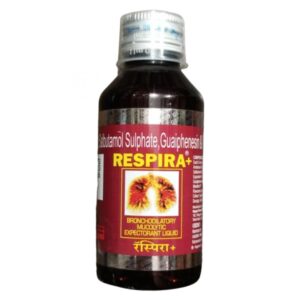SALBUTAMOL + AMBROXOL + GUAIPHENESIN
Salbutamol: Salbutamol, also known as albuterol, is a medication primarily used to treat asthma and other obstructive pulmonary diseases. It belongs to a class of drugs called bronchodilators, which work by relaxing the muscles in the airways, opening them up and making it easier to breathe.
The main use of salbutamol is in the management and prevention of asthma symptoms such as wheezing, coughing, shortness of breath, and chest tightness. It is also used to prevent exercise-induced asthma. Additionally, salbutamol can be used in the treatment of other conditions that cause bronchospasm, including chronic obstructive pulmonary disease (COPD).
Salbutamol is available in various forms, including inhalers (metered-dose inhaler or dry powder inhaler), nebulizer solution, tablets, and syrup. The appropriate dosage and form depend on individual patient factors, such as age, severity of the condition, and response to treatment. The medication can be used on an as-needed basis for quick relief of symptoms or on a regular schedule as a maintenance therapy.
The mechanism of action of salbutamol involves stimulation of beta-2 adrenergic receptors in the muscles that surround the airways. This stimulation causes relaxation of the smooth muscles, leading to bronchodilation and improved airflow to the lungs. It also helps to suppress the release of histamine, which can trigger asthma symptoms.
As with any medication, salbutamol can cause side effects. Common side effects include tremors, palpitations, increased heart rate, headache, muscle cramps, and nervousness. These side effects are usually mild and temporary. However, in rare cases, salbutamol can cause more severe side effects such as chest pain, irregular heart rhythm, allergic reactions, and paradoxical bronchospasm (worsening of breathing difficulties).
It is important to use salbutamol as prescribed and to follow the instructions provided by healthcare professionals. If side effects are bothersome or if there is a lack of symptom relief, it is recommended to contact a healthcare provider for further evaluation and adjustment of the treatment plan.
Ambroxol: Ambroxol is a medication commonly used as a mucolytic agent, primarily for the treatment of respiratory diseases such as chronic obstructive pulmonary disease (COPD), asthma, and bronchitis. It is also used to aid in the management of respiratory conditions associated with excessive mucus production.
The main mechanism of action of Ambroxol is the stimulation of the production and secretion of respiratory tract fluid. It promotes the synthesis and release of surfactant, which helps to reduce the viscosity of mucus, making it easier to expectorate.
The usual dosage of Ambroxol depends on the form of the medication and the age of the patient. For adults, the typical oral dose is 30 mg three times a day, while for children, the dose is generally lower and adapted according to their age. The dosage may vary, so it is important to follow the instructions given by a healthcare professional.
Common side effects of Ambroxol include gastrointestinal disturbances such as nausea, vomiting, diarrhea, and abdominal pain. Some individuals may experience hypersensitivity reactions such as rash, itching, or swelling, which should be promptly reported to a doctor. In rare cases, Ambroxol may cause severe allergic reactions or liver problems. It is recommended to seek medical attention if any unusual or severe side effects occur.
Ambroxol is generally considered safe and well-tolerated, particularly when used as recommended. However, it is essential to consult a healthcare professional before starting any medication to ensure its appropriateness and to discuss potential risks and benefits, especially if you have any pre-existing medical conditions or are taking other medications.
Guaiphenesin: Guaifenesin is an expectorant drug commonly used to help relieve cough and congestion caused by respiratory conditions such as the common cold, bronchitis, or sinusitis. It works by loosening and thinning mucus in the airways, making it easier to cough up and clear the respiratory passages.
The exact mechanism of action of guaifenesin is not fully understood. However, it is thought to work by increasing the production and secretion of respiratory tract fluid, which helps to lubricate and clear the airways. This can help to reduce the viscosity of mucus and promote its removal through coughing.
Guaifenesin is typically available in tablet or liquid form and can be taken orally. The recommended dose for adults is usually 600-1200 mg every 12 hours, with a maximum daily dose of 2400 mg. For children, the dose is usually based on their weight and age, and it is important to follow the dosing instructions on the packaging or as directed by a healthcare professional.
Common side effects of guaifenesin may include nausea, vomiting, upset stomach, drowsiness, dizziness, or headache. These side effects are usually mild and resolve on their own. However, if any severe or persistent side effects occur, it is important to seek medical attention.
Guaifenesin is generally considered safe for most individuals when used as directed. However, it is always important to talk to a doctor or pharmacist before starting any new medication, especially if you have any pre-existing health conditions or are taking other medications, to ensure that it is safe and appropriate for you.

